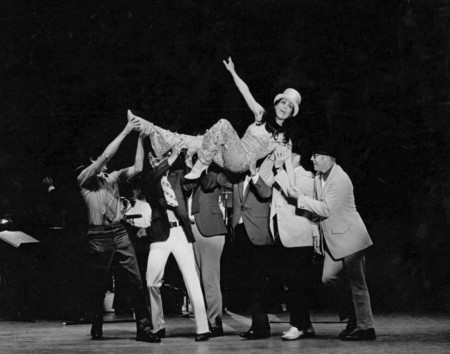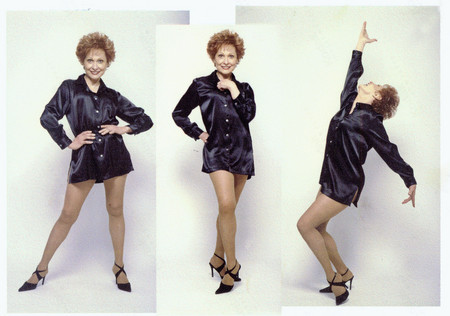One Step At a Time
EDITOR'S NOTE: This is part of an occasional series of stories highlighting performers who played an interesting role in the history of entertainment in Las Vegas.
Forever remembered as Maria in Broadway's "West Side Story," Carol Lawrence is what is called in the industry a "triple threat." She is not only a singer and actress, but a trained dancer.
These skills served her well in Las Vegas, both as a solo act and with her former husband Robert Goulet.
When she made her Las Vegas debut at the Flamingo on Dec. 27, 1963, she stunned audiences and critics alike with her dancing prowess and her comedic skills, as well as with her strong singing.
Lawrence recently told me it was typical in those days to follow a Broadway show with a nightclub act.
"I opened my act at the Persian Room (in New York), and it was very, very successful. Ed Sullivan said that it was the greatest act he'd ever seen. And so on those reviews I was booked all over the U.S. The first place I really went to was Las Vegas, and the Flamingo, which was a wonderful club at the time."
Lawrence remembered her Las Vegas debut as an exciting experience.
"I had two boys dancing with me (Bob Lone and Steve Harmon). To me, it was a marvelously diverse act in that I was singing and dancing and I came on in my opening number dressed as one of my boys, pretending he was late. So it was a crisis on the stage. I approached the whole club act as if it was a Broadway show. In a Broadway show, of course, you have to have conflict and crisis and excitement and interaction."
I asked Lawrence if that first appearance was daunting. "You know, you just keep working the audience until they're on your side," she explained. "That's why I came on in this very vulnerable position. I didn't want to come on as a lady in gorgeous gowns and alienate half the audience, and all the women are looking at your gowns and saying, 'Oh, I'll never be able to afford one of those.' But if I came on dressed as one of the boys and try to cover up the fact that he was late getting there -- that was the premise of the number. And I decided I would dance his part and sing his part."
Lawrence continued: "And then I was teased into the song 'I'll Do Anything,' from 'Oliver' ... and I would tap dance, and stand on my head, until 'Johnny' (the character in the act) finally did arrive, and we began dancing. ... (Then) I ran off in his tuxedo and he started dancing the beginning of it, and in about 30 seconds I came back on fully dressed in this beautiful Ginger Rogers gown. So the audience by that time were laughing and on your side and trying to make everything work. And it really warmed them up completely."
Lawrence said she had a strong team working on the show, including musical director Joe Harnell, conductor Luther Henderson (at the Persian Room) and costumes by Milo.
"The whole act was choreographed and directed by Tony Chamoli, and he was brilliant," she told me. "It was his idea to have me tap dance because a lot of people didn't know I could. ... But his idea was to make dance a big part of the show. ... He had the idea of my performing on a 10-foot ladder on coasters, very much like an electrician's ladder. And it was a very dangerous act because I was singing and dancing on the ladder as it was being pushed around and twirled by the two boys. The audience was really close to it and you could sense the danger. And I did fall off it. ... But if you could get back on and finish the number it would stop the show cold! It was a wonderful, wonderfully exciting number."
Lawrence had prepared long and hard for her Las Vegas debut. And she had paid her dues on the New York stage. Born Carol Maria LaRaia in Melrose Park, Ill., on Sept. 5, 1932, Lawrence made her Broadway debut in "Leonard Sillman's New Faces of 1952."
She honed her craft as a dancer as a replacement in the popular show "Plain and Fancy" at the Mark Hellinger Theater in 1955, and she portrayed Liat in a revival of "South Pacific" the same year.
After two more appearances on Broadway (in "Shangri-La," with Jack Cassidy and Dennis King, and "Ziegfeld Follies of 1957," with Beatrice Lillie and Billy DeWolfe), Lawrence was immortalized as Maria in "West Side Story."
Produced by Harold Prince, book by Arthur Laurents, and music by Leonard Bernstein and Stephen Sondheim, "West Side Story" opened to critical acclaim at New York's Winter Garden Theater on Sept. 26, 1957.
Lawrence's career took off after "West Side Story," and she made numerous dramatic and variety appearances on television.
There were other Broadway shows as well, including "Saratoga" in 1959, "Subways Are for Sleeping" in 1961 and "I Do! I Do!" in 1968.
It also was during this time that Lawrence married singer and Broadway star Goulet (she had brief marriages to Cosmo Allegretti in 1956 and later to John Gregory Guydus in 1982). Lawrence and Goulet, star of "Camelot," were married Aug. 12, 1963. (They would divorce in December 1980, after having two sons, born in 1964 and 1966.)
Returning to the desert, Lawrence headlined at the Sands in March 1965. She was at the Riviera in November 1968 and in April 1972, and in May 1973, she co-starred with Shecky Greene.
In June 1972, July 1973 and February 1974, Lawrence and Goulet headlined at the Frontier together.
"I did a big moon number at the Frontier," Lawrence recalled. "I was flown in on a beautiful aluminum round-faced moon on wires, of course. And I would be sitting on the moon's face, like on his nose, like it was a crescent moon. And I had a handle where I was standing. And the moon would sweep across the stage and it would dip down, and then pull up. And I was singing 'Fly Me to the Moon,' or something, and turning. And I had no straps or wires to catch me if I was falling off.
"I also did a tribute to Bill ('Bojangles') Robinson and we re-created his steps (with Shirley Temple). ... We had two staircases built on the sides (of the stage) at the proscenium arch so that I was dancing up and down this staircase and then up and down the other, and then run across the stage. ... Oh, it was wonderful. We broke the record completely at the Frontier," she added.
Lawrence would appear at the Frontier again as a solo act in September 1974. Her opening act was Jerry Vale. She also would perform at the Sands and the Desert Inn.
"We did two shows a night, every day," Lawrence recalled of her time in Las Vegas. "Bobby and I played once for six weeks there at consecutive times, and it was sometimes you didn't know what day it was.
"We were very close to Norm Crosby ... (and when he was) going to get married, they asked us to be maid of honor and best man. So I flew in (to Las Vegas) and bought a wedding gown. And I knew his in-laws were there for the night and the next day (Norm and his bride) were to be married.
"I hired a security man to come (onstage) with me and to 'arrest' him," she added, chuckling. "I put a pillow in the dress and said he'd left me pregnant and at the altar. And he said: 'No, no Carol! Please don't do this!' It was absolutely hysterical. That's the kind of thing you could do and get away with at the time. The audience was in on it."
Lawrence also toured in national musical stage productions, and appeared again on Broadway in "The Kiss of the Spider Woman" in the early 1990s. She has hosted her own television show, "The Carol Lawrence Show," made numerous recordings and penned her autobiography in 1990, "Carol Lawrence, The Backstage Story" (McGraw-Hill), and a best-selling cookbook, "I Remember Pasta" (Harvest House).
The recipient of both Grammy Award and Tony Award nominations, Lawrence continues to entertain today. She recently appeared as herself in Rick McKay's film documentary, "Broadway -- The Golden Age, by the Legends Who Were There," reminiscing about the glory days of the Broadway stage.
Like many other entertainers profiled in Legendary Las Vegas Headliners, Lawrence laments the decline of variety shows.
"They don't know how to do it," she said. "And they've completely outpriced themselves with all the unions and such. It is a perfect venue (for an artist) to just do a number and just go out into millions of people's homes. And that's what the (Ed) Sullivan show would do. People would come up to you on the street and talk to you like you were a buddy from high school."
Another strength of the format was audience interaction.
"I do a number in Vegas and in so many other clubs and theaters where I literally invite six men up out of the audience onto the stage and put on top hats and canes and teach them ... a routine -- swaying is one step, walking and tapping the cane is another step. And then I say, 'Now put your canes down, because you're going to lift me up and carry me off.' And that's when it gets hysterical. And nobody has ever dropped me. Nobody has ever been rude. ... They're all such good sports ... they're incredibly funny. They become part of the party. And that's what entertaining is supposed to do."




















